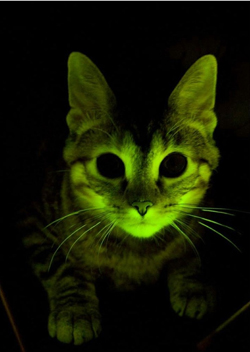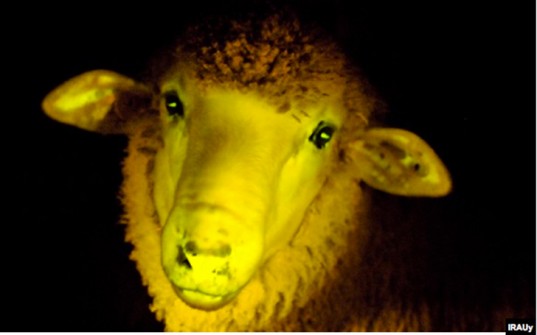It looks like you're using an Ad Blocker.
Please white-list or disable AboveTopSecret.com in your ad-blocking tool.
Thank you.
Some features of ATS will be disabled while you continue to use an ad-blocker.
2
share:
IRAUy, connected to the Genetically Modified Animals Unit of the Pasteur Institute, has raised a flock of nine “brilliant lambs” that they have
engineered to glow green under ultra-violet light. While most animal engineering is occupied with modifying organisms to produce compounds useful to
humans through their milk, such as growth hormone or insulin, the project was intended to solely refine methods of manipulation.
“We did not use a protein of medical interest or to help with a particular medicine because we wanted to fine-tune the technique. We used the green protein because the color is easily identifiable in the sheep’s tissues,” Alejo Menchaca, the head of the research team told the South Atlantic News Agency. “Our focus is generating knowledge, make it public so the scientific community can be informed and help in the long run march to generate tools so humans can live better, but we’re not out in the market to sell technology.”
The project raises a myriad of ethical questions, ranging from whether or not jellyfish genetics belong in a grazing mammal, to what the long-term implications of altering an established genome will affect the well-being of both animals and humans. The team at IRAUy insists that the sheep behave normally and are closely monitored. Yet, despite appearing to function without incident, the full consequences of furthering such research has yet to be seen. The scientists hope to trigger the interest of the pharmaceutical industry, opening up a new avenue of debate as to the safety and moral ramifications of engineering animals to produce substances intended for human health.


First there were glow-in-the-dark fish, then rats, rabbits, insects, even pigs. And, now, researchers have inserted the jellyfish genes that make fluorescent proteins into Felis catus, or the common household cat.
The goal was just to make sure that the researchers could successfully insert novel genes into the cats. Past efforts at cloning and injecting DNA into fertilized cat embryos, among other genetic modification techniques, had failed. But the good doctors at the Mayo Clinic and Yamaguchi University in Japan succeeded by injecting a lentivirus bearing the novel genetics directly into unfertilized cat eggs. (Human immunodeficiency viruses 1 and 2 (HIV-1 and HIV-2), feline immunodeficiency virus (FIV) and simian immunodeficiency virus (SIV) are all lentiviruses, named for their slow incubation period.)
Source
Im not quite sure where I stand on this. Are they just doing this because they can or is there another reason?
Why do we need glow in the dark animals? And what are the implications for giving animals jelly fish DNA?
This just seems pointless. Either that or someone was just very bored in the lab one day
“We did not use a protein of medical interest or to help with a particular medicine because we wanted to fine-tune the technique. We used the green protein because the color is easily identifiable in the sheep’s tissues,” Alejo Menchaca, the head of the research team told the South Atlantic News Agency. “Our focus is generating knowledge, make it public so the scientific community can be informed and help in the long run march to generate tools so humans can live better, but we’re not out in the market to sell technology.”
The project raises a myriad of ethical questions, ranging from whether or not jellyfish genetics belong in a grazing mammal, to what the long-term implications of altering an established genome will affect the well-being of both animals and humans. The team at IRAUy insists that the sheep behave normally and are closely monitored. Yet, despite appearing to function without incident, the full consequences of furthering such research has yet to be seen. The scientists hope to trigger the interest of the pharmaceutical industry, opening up a new avenue of debate as to the safety and moral ramifications of engineering animals to produce substances intended for human health.


First there were glow-in-the-dark fish, then rats, rabbits, insects, even pigs. And, now, researchers have inserted the jellyfish genes that make fluorescent proteins into Felis catus, or the common household cat.
The goal was just to make sure that the researchers could successfully insert novel genes into the cats. Past efforts at cloning and injecting DNA into fertilized cat embryos, among other genetic modification techniques, had failed. But the good doctors at the Mayo Clinic and Yamaguchi University in Japan succeeded by injecting a lentivirus bearing the novel genetics directly into unfertilized cat eggs. (Human immunodeficiency viruses 1 and 2 (HIV-1 and HIV-2), feline immunodeficiency virus (FIV) and simian immunodeficiency virus (SIV) are all lentiviruses, named for their slow incubation period.)
Source
Im not quite sure where I stand on this. Are they just doing this because they can or is there another reason?
Why do we need glow in the dark animals? And what are the implications for giving animals jelly fish DNA?
This just seems pointless. Either that or someone was just very bored in the lab one day
reply to post by sarahlm
If you read what you posted, it pretty much answers your questions.
Making them fluoresce under UV light is used because it is a very simple thing to test and see if it worked.
The point, is to refine the technique of inserting genes into other animals. They are working their way up from fish, eventually they should be able to reliably manipulate human genes, or insert/remove them.
The benefits of this should be obvious, diseases the are passed down from parents to children could eventually be removed from a developing embryo, or even just a counter to an inherent problem.
If you read what you posted, it pretty much answers your questions.
Making them fluoresce under UV light is used because it is a very simple thing to test and see if it worked.
The point, is to refine the technique of inserting genes into other animals. They are working their way up from fish, eventually they should be able to reliably manipulate human genes, or insert/remove them.
The benefits of this should be obvious, diseases the are passed down from parents to children could eventually be removed from a developing embryo, or even just a counter to an inherent problem.
Being able to insert a missing gene where the gene deficiency is already known is only partly useful.
My problem with this is the use of a HIV like virus used to insert the gene.
What about the rest of the viral RNA?
Be born free of a genetic illness but have AIDS as a consequence?
That sounds like a bad deal.
My problem with this is the use of a HIV like virus used to insert the gene.
What about the rest of the viral RNA?
Be born free of a genetic illness but have AIDS as a consequence?
That sounds like a bad deal.
reply to post by Theflyingweldsman
I agree, that gave me pause as well when I saw that.
I will do some more looking into it when I get into work. I understand why they would use it, for research anyway. But any further advancement would require some other means of delivery.
I agree, that gave me pause as well when I saw that.
I will do some more looking into it when I get into work. I understand why they would use it, for research anyway. But any further advancement would require some other means of delivery.
Where do we purchase these??? I imagine any local pet shop in or around the Fukushima area will now have them in stock! LoL
This has been posted many times now
www.abovetopsecret.com...
www.abovetopsecret.com...
Search is your friend
www.abovetopsecret.com...
www.abovetopsecret.com...
Search is your friend
new topics
-
Agree or Disagree
2024 Elections: 30 minutes ago -
Leaving the US due to severe TDS?
US Political Madness: 1 hours ago -
Just a thought by Matt Walsh on the election
2024 Elections: 10 hours ago -
Trump's truth and reconciliation commission
Politicians & People: 11 hours ago -
Liberal women going on sex strike over Trump win
US Political Madness: 11 hours ago
top topics
-
Where ARE the 20 million votes??? Where ARE they????? WHERE???
US Political Madness: 13 hours ago, 28 flags -
Just a thought by Matt Walsh on the election
2024 Elections: 10 hours ago, 17 flags -
The Democratic Party’s Stay Behind Program
US Political Madness: 15 hours ago, 13 flags -
President-Elect DONALD TRUMP's 2nd-Term Administration Takes Shape.
Political Ideology: 14 hours ago, 13 flags -
82 yr Woman Arrested for Hate Crime after Assaulting Trump Supporters
2024 Elections: 17 hours ago, 10 flags -
Liberal women going on sex strike over Trump win
US Political Madness: 11 hours ago, 8 flags -
Celestial Objects in Far Northern Reaches of Alaska (Polar Mystery)
Fragile Earth: 16 hours ago, 7 flags -
Leaving the US due to severe TDS?
US Political Madness: 1 hours ago, 4 flags -
Trump's truth and reconciliation commission
Politicians & People: 11 hours ago, 2 flags -
Agree or Disagree
2024 Elections: 30 minutes ago, 2 flags
2
